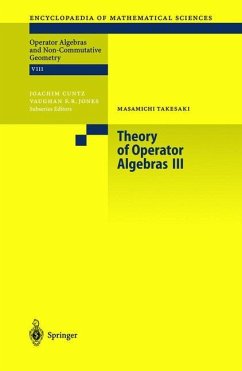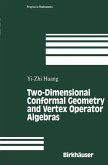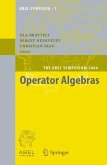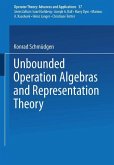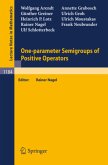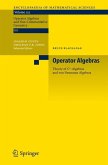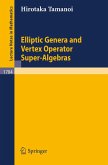Together with "Theory of Operator Algebras I, II" (EMS 124 and 125), this book, written by one of the most prominent researchers in the field of operator algebras, presents the theory of von Neumann algebras and non-commutative integration focusing on the group of automorphisms and the structure analysis.
It is is part of the recently developed part of the "Encyclopaedia of Mathematical Sciences" on operator algebras and non-commutative geometry (see http://www.springer.de/math/ems/index.html). The book provides essential and comprehensive information for graduate students and researchers in mathematics and mathematical physics.
to the Encyclopaedia Subseries on Operator Algebras and Non-Commutative Geometry The theory of von Neumann algebras was initiated in a series of papers by Murray and von Neumann in the 1930's and 1940's. A von Neumann algebra is a self-adjoint unital subalgebra M of the algebra of bounded operators of a Hilbert space which is closed in the weak operator topology. According to von Neumann's bicommutant theorem, M is closed in the weak operator topology if and only if it is equal to the commutant of its commutant. A factor is a von Neumann algebra with trivial centre and the work of Murray and von Neumann contained a reduction of all von Neumann algebras to factors and a classification of factors into types I, II and III. C_ -algebras are self-adjoint operator algebras on Hilbert space which are closed in the norm topology. Their study was begun in the work of Gelfand and Naimark who showed that such algebras can be characterized abstractly as involutive Banach algebras, satisfyingan algebraic relation connecting the norm and the involution. They also obtained the fundamental result that a commutative unital C_ -algebra is isomorphic to the algebra of complex valued continuous functions on a compact space - its spectrum. Since then the subject of operator algebras has evolved into a huge mathematical endeavour interacting with almost every branch of mathematics and several areas of theoretical physics.
Hinweis: Dieser Artikel kann nur an eine deutsche Lieferadresse ausgeliefert werden.
It is is part of the recently developed part of the "Encyclopaedia of Mathematical Sciences" on operator algebras and non-commutative geometry (see http://www.springer.de/math/ems/index.html). The book provides essential and comprehensive information for graduate students and researchers in mathematics and mathematical physics.
to the Encyclopaedia Subseries on Operator Algebras and Non-Commutative Geometry The theory of von Neumann algebras was initiated in a series of papers by Murray and von Neumann in the 1930's and 1940's. A von Neumann algebra is a self-adjoint unital subalgebra M of the algebra of bounded operators of a Hilbert space which is closed in the weak operator topology. According to von Neumann's bicommutant theorem, M is closed in the weak operator topology if and only if it is equal to the commutant of its commutant. A factor is a von Neumann algebra with trivial centre and the work of Murray and von Neumann contained a reduction of all von Neumann algebras to factors and a classification of factors into types I, II and III. C_ -algebras are self-adjoint operator algebras on Hilbert space which are closed in the norm topology. Their study was begun in the work of Gelfand and Naimark who showed that such algebras can be characterized abstractly as involutive Banach algebras, satisfyingan algebraic relation connecting the norm and the involution. They also obtained the fundamental result that a commutative unital C_ -algebra is isomorphic to the algebra of complex valued continuous functions on a compact space - its spectrum. Since then the subject of operator algebras has evolved into a huge mathematical endeavour interacting with almost every branch of mathematics and several areas of theoretical physics.
Hinweis: Dieser Artikel kann nur an eine deutsche Lieferadresse ausgeliefert werden.
"... Das Buch ist eine praktisch unabdingbare Ergänzung zum zweiten Band. Während im zweiten Band fast ausschließlich die theoretischen Grundlagen und kaum Anwendungen entwickelt werden, stehen hier Beispiele und interessante Spezialfälle der Theorie im Mittelpunkt. Auf über 500 Seiten werden ergodische Transformationsgruppen, injektive von-Neumann-Algebren, nichtkommutative Ergodentheorie und die Strukturtheorie von hyperfiniten Typ II1 von-Neumann Faktoren behandelt. Besonders erwähnenswert ist hierbei die gelungene Einführung von messbaren Gruppoiden im Kontext der Ergodentheorie. Wie schon Band II wird auch dieser Band dem Anspruch der Buchreihe gerecht, den besonderen Blickwinkel der nichtkommutativen Geometrie zu berücksichtigen. In Verbindung mit dem zweiten Band liegt damit eine äußerst anregende Zusammenstellung von Themen der Operatoralgebra vor, die besonders im Hinblick auf Anwendungen in der nichtkommutativen Geometrie für ein breites Fachpublikum interessant sein wird. Im gewohnt knappen aber sehr klaren Takesaki-Stil gehalten, empfiehlt sich die Anschaffung dieses dritten Bandes als notwendiges Supplement zum zweiten Band. ..." Christian Blohmann, Spektrum direkt, www.wissenschaft-online.de
From the reviews:
"... These three bulky volumes [EMS 124, 125, 127], written by one of the most prominent researchers of the area, provide an introduction to this repidly developing theory. ... These books can be warmly recommended to every graduate student who wants to become acquainted with this exciting branch of matematics. Furthermore, they should be on the bookshelf of every researcher of the area."
László Kérchy, Acta Scientiarum Mathematicarum, Vol. 69, 2003
"... In summary, the author deserves the special thanks of the entire operaotr algebra community for writing this comprehensive three-volume work [Theory of Operator Algebras I-III]. Some of the most beautiful (and I might add the most difficult) mathematics ever written can be found in the pages of these volumes. The author has been one of the pincipal contributors to the theory over many years. He has done an excellent job conveying the drama of discovery in this deep and exciting area of mathematics. ... they clearly belong on the bookshelp of every serious researcher in operator algebras."
R.S.Doran, Mathematical Reviews Clippings from Issue 2004g
"... Das Buch ist eine praktisch unabdingbare Ergänzung zum zweiten Band. Während im zweiten Band fast ausschließlich die theoretischen Grundlagen und kaum Anwendungen entwickelt werden, stehen hier Beispiele und interessante Spezialfälle der Theorie im Mittelpunkt. Auf über 500 Seiten werden ergodische Transformationsgruppen, injektive von-Neumann-Algebren, nichtkommutative Ergodentheorie und die Strukturtheorie von hyperfiniten Typ II1 von-Neumann Faktoren behandelt. Besonders erwähnenswert ist hierbei die gelungene Einführung von messbaren Gruppoiden im Kontext der Ergodentheorie.
Wie schon Band II wird auch dieser Band dem Anspruch der Buchreihe gerecht, den besonderen Blickwinkel der nichtkommutativen Geometrie zu berücksichtigen. In Verbindung mit dem zweiten Band liegt damiteine äußerst anregende Zusammenstellung von Themen der Operatoralgebra vor, die besonders im Hinblick auf Anwendungen in der nichtkommutativen Geometrie für ein breites Fachpublikum interessant sein wird.
Im gewohnt knappen aber sehr klaren Takesaki-Stil gehalten, empfiehlt sich die Anschaffung dieses dritten Bandes als notwendiges Supplement zum zweiten Band. ..."
Christian Blohmann, Spektrum direkt, www.wissenschaft-online.de
"This is the third volume of a modern book written by one of the main contributors to the theory of operator algebras and is useful for researchers. ... The third volume is a comprehensive account of structure analysis of approximately finite dimensional factors and their automorphism groups ... . Each chapter begins with a clear introduction describing the content of that chapter, contains several interesting exercises and is concluded with a section of rich historical notes." (Mohammad Sal Moslehian, Zentralblatt MATH, Vol. 1059 (10), 2005)
"This book is the third volume in the author's three-volume set on operator algebras. ... the author deserves the special thanks of the entire operator algebra community for writing this comprehensive three-volume work. ... He has done an excellent job conveying the drama of discovery in this deep and exciting area of mathematics. ... clearly belong on the bookshelf of every serious researcher in operator algebras." (Robert S. Doran, Mathematical Reviews, 2004 g)
"Volume III is devoted to approximately finite-dimensional (AFD) von Neumann algebras, i.e. those which are inductive limits of finite-dimensional subalgebras. ... Let us mention that the book is carefully written. Each chapter ends with exercises, and with interesting historical notes. ... it can be recommended to the expert aiming at a self-contained proof of the classification of approximately finite-dimensional factors, one monument of 20th-century mathematics." (Alain Valette,Bulletin of the Belgian Mathematical Society, 2007)
"... These three bulky volumes [EMS 124, 125, 127], written by one of the most prominent researchers of the area, provide an introduction to this repidly developing theory. ... These books can be warmly recommended to every graduate student who wants to become acquainted with this exciting branch of matematics. Furthermore, they should be on the bookshelf of every researcher of the area."
László Kérchy, Acta Scientiarum Mathematicarum, Vol. 69, 2003
"... In summary, the author deserves the special thanks of the entire operaotr algebra community for writing this comprehensive three-volume work [Theory of Operator Algebras I-III]. Some of the most beautiful (and I might add the most difficult) mathematics ever written can be found in the pages of these volumes. The author has been one of the pincipal contributors to the theory over many years. He has done an excellent job conveying the drama of discovery in this deep and exciting area of mathematics. ... they clearly belong on the bookshelp of every serious researcher in operator algebras."
R.S.Doran, Mathematical Reviews Clippings from Issue 2004g
"... Das Buch ist eine praktisch unabdingbare Ergänzung zum zweiten Band. Während im zweiten Band fast ausschließlich die theoretischen Grundlagen und kaum Anwendungen entwickelt werden, stehen hier Beispiele und interessante Spezialfälle der Theorie im Mittelpunkt. Auf über 500 Seiten werden ergodische Transformationsgruppen, injektive von-Neumann-Algebren, nichtkommutative Ergodentheorie und die Strukturtheorie von hyperfiniten Typ II1 von-Neumann Faktoren behandelt. Besonders erwähnenswert ist hierbei die gelungene Einführung von messbaren Gruppoiden im Kontext der Ergodentheorie.
Wie schon Band II wird auch dieser Band dem Anspruch der Buchreihe gerecht, den besonderen Blickwinkel der nichtkommutativen Geometrie zu berücksichtigen. In Verbindung mit dem zweiten Band liegt damiteine äußerst anregende Zusammenstellung von Themen der Operatoralgebra vor, die besonders im Hinblick auf Anwendungen in der nichtkommutativen Geometrie für ein breites Fachpublikum interessant sein wird.
Im gewohnt knappen aber sehr klaren Takesaki-Stil gehalten, empfiehlt sich die Anschaffung dieses dritten Bandes als notwendiges Supplement zum zweiten Band. ..."
Christian Blohmann, Spektrum direkt, www.wissenschaft-online.de
"This is the third volume of a modern book written by one of the main contributors to the theory of operator algebras and is useful for researchers. ... The third volume is a comprehensive account of structure analysis of approximately finite dimensional factors and their automorphism groups ... . Each chapter begins with a clear introduction describing the content of that chapter, contains several interesting exercises and is concluded with a section of rich historical notes." (Mohammad Sal Moslehian, Zentralblatt MATH, Vol. 1059 (10), 2005)
"This book is the third volume in the author's three-volume set on operator algebras. ... the author deserves the special thanks of the entire operator algebra community for writing this comprehensive three-volume work. ... He has done an excellent job conveying the drama of discovery in this deep and exciting area of mathematics. ... clearly belong on the bookshelf of every serious researcher in operator algebras." (Robert S. Doran, Mathematical Reviews, 2004 g)
"Volume III is devoted to approximately finite-dimensional (AFD) von Neumann algebras, i.e. those which are inductive limits of finite-dimensional subalgebras. ... Let us mention that the book is carefully written. Each chapter ends with exercises, and with interesting historical notes. ... it can be recommended to the expert aiming at a self-contained proof of the classification of approximately finite-dimensional factors, one monument of 20th-century mathematics." (Alain Valette,Bulletin of the Belgian Mathematical Society, 2007)
